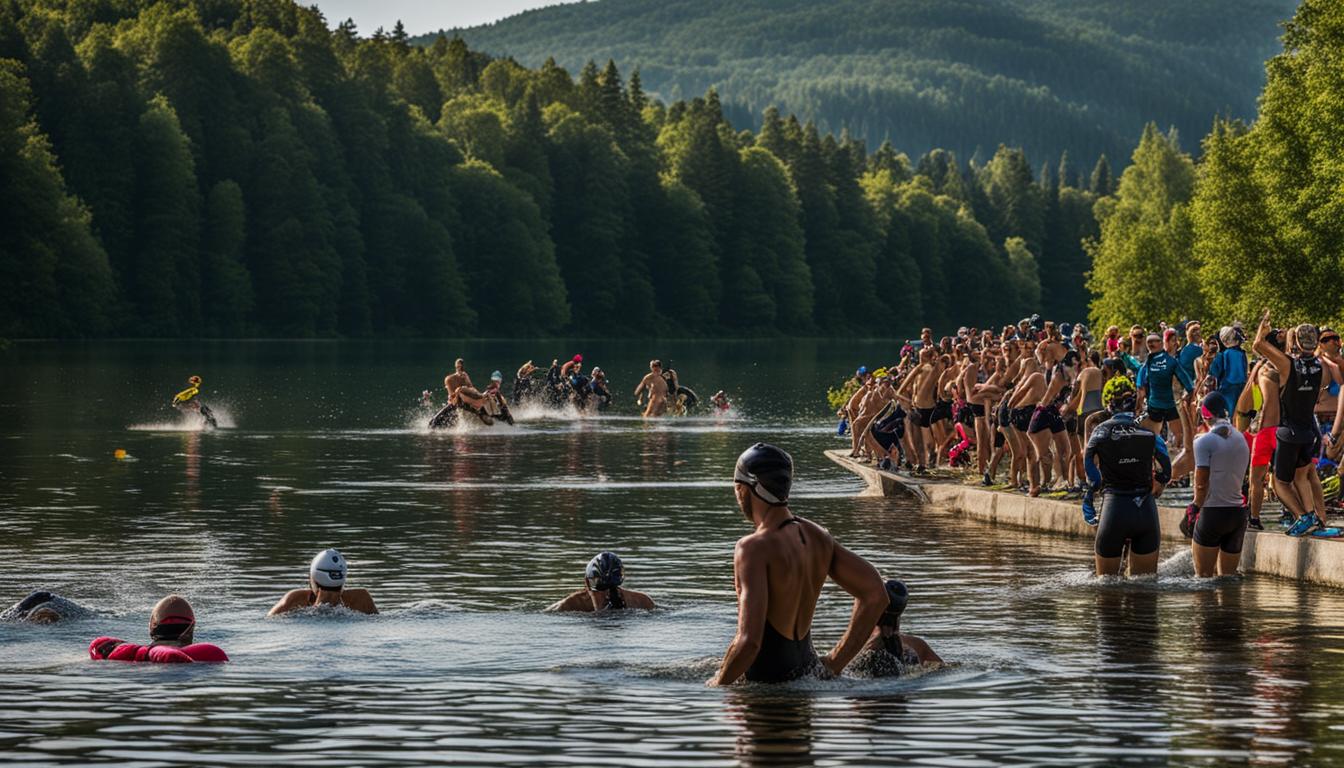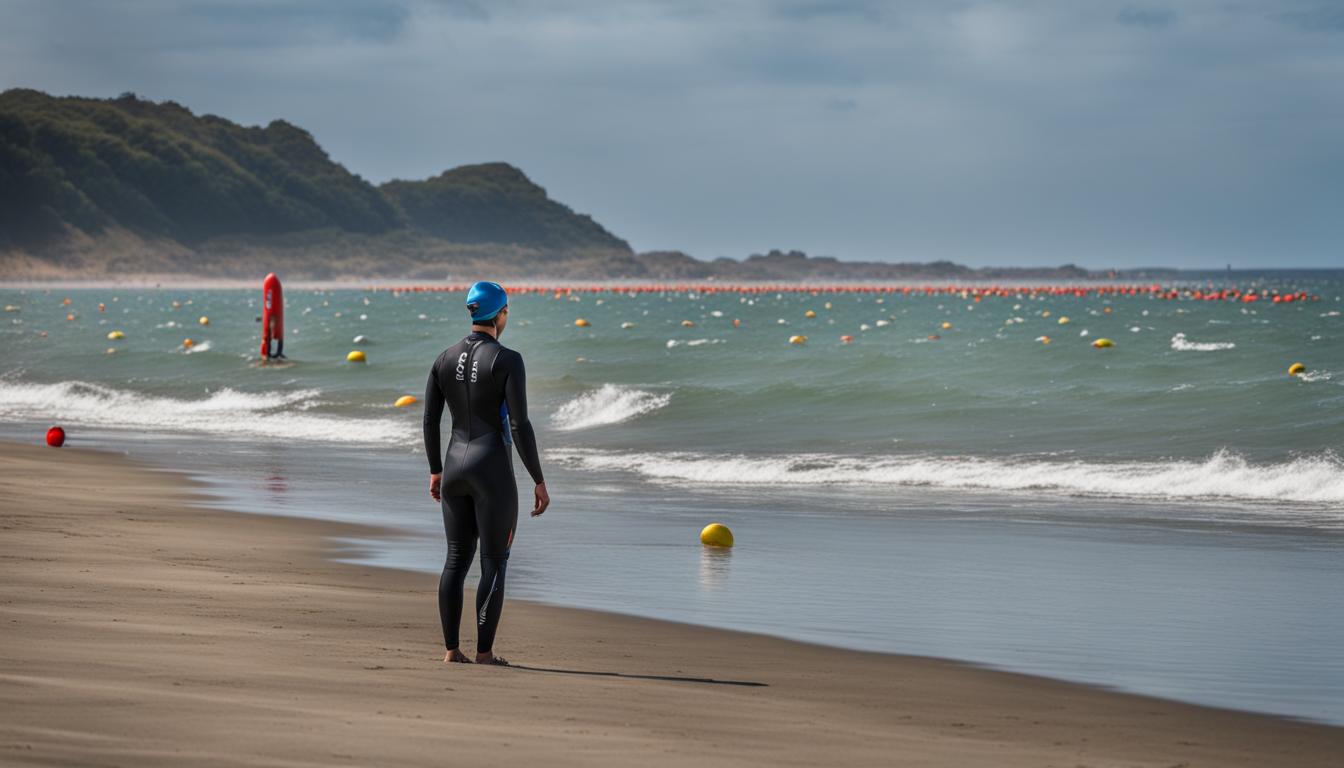Getting started with training for your first triathlon can be overwhelming. There are three sports to train for: swim, bike, and run. But with the right guidance and preparation, anyone can successfully train for and complete a triathlon. In this beginner’s guide, we will cover everything you need to know, from training and nutrition to gear and race strategies, to help you confidently tackle your first triathlon.
Key Takeaways:
- Triathlon preparation requires training in three disciplines: swim, bike, and run.
- Proper nutrition is essential for fueling your body during training and on race day.
- Invest in the right triathlon gear, including a wetsuit, bike, helmet, and running shoes.
- Develop a training plan that includes a balanced mix of endurance and speed workouts.
- Practice your triathlon transitions to minimize time loss during the race.
Can I do a triathlon?
Triathlon is a sport for everyone. Regardless of your age, shape, size, or ability, you can participate and enjoy the thrill of triathlon. Many successful triathletes started as beginners, just like you, and gradually worked their way up to more challenging races. So whether you’re a seasoned 5K runner looking for a new challenge or someone seeking to improve their overall fitness and health, triathlon is accessible to all.
Triathlon offers a unique opportunity to push your limits and achieve personal goals. It’s not just a race against others; it’s a journey of self-discovery and perseverance. Each individual brings their unique story and sets their own pace. Embrace the spirit of the triathlon and remember that every accomplished triathlete was once a beginner, just like you.
Triathlon is not limited by age. You may be surprised to find participants in their 70s and beyond competing and completing triathlons alongside younger athletes. It’s never too late to start your triathlon journey and experience the incredible sense of achievement that comes with crossing the finish line.
Triathlon is also inclusive of different abilities. Whether you’re a beginner or an experienced athlete with physical challenges, there are adaptations and support available to ensure you can participate. Triathlon organizations and events prioritize inclusivity and provide opportunities for everyone to be part of the triathlon community.
Remember, triathlon is not just a sport; it’s a lifestyle. It’s about challenging yourself, setting goals, and embracing the journey. So don’t hesitate to take that first step and embark on your triathlon adventure. You might surprise yourself with what you can achieve.
How far is a triathlon?
Triathlons come in various distances, offering something for everyone. Whether you’re a beginner looking for a shorter race or an experienced triathlete seeking a greater challenge, there’s a triathlon distance suited to your goals and abilities.
The shortest triathlon distance is known as the super sprint triathlon. This introductory race typically involves a 500-meter swim, six-mile bike ride, and a one-mile run, making it ideal for those who want to test the waters of triathlon without committing to a longer distance.
The most common distance for beginners is the sprint triathlon. This race consists of a 750-meter swim, 20-kilometer bike ride, and a 5-kilometer run. The sprint triathlon provides a manageable challenge for new triathletes and allows them to experience the thrill of completing all three disciplines.
For those seeking a more demanding race, there’s the Olympic triathlon. This distance involves a 1.5-kilometer swim, 40-kilometer bike ride, and a 10-kilometer run. The Olympic triathlon is a popular choice for triathletes looking to push themselves further and step up from the sprint distance.
If you’re ready to take on an even greater challenge, there’s the Half-Iron/70.3 triathlon. This race includes a 1.9-kilometer swim, 90-kilometer bike ride, and a 21.1-kilometer run. The Half-Iron/70.3 distance requires a higher level of endurance and training, making it a significant milestone for many triathletes.
Finally, for those who dream of conquering the ultimate triathlon distance, there’s the Ironman/Iron-distance triathlon. This grueling race consists of a 3.8-kilometer swim, 180-kilometer bike ride, and a full marathon, which is a 42.2-kilometer run. The Ironman distance is the pinnacle of triathlon achievement, challenging participants both physically and mentally.
Choosing Your First Triathlon Race
When it comes to picking your first triathlon race, there are a few factors to consider in order to ensure a positive experience. One important consideration is the distance of the race. For beginners, it is recommended to start with a super-sprint or sprint triathlon. These distances are manageable for new triathletes and allow you to focus on mastering the fundamentals of swimming, biking, and running.
Another factor to consider is your race motivation. What drives you to participate in a triathlon? Is it the support and cheering of your family and friends? Do you have a specific type of race in mind, such as a beach triathlon? Or perhaps you have always dreamt of competing in one of the iconic triathlon races around the world. Identifying your motivation can provide you with the extra push and excitement needed to stay committed to your training and cross that finish line.
To help you visualize the excitement of participating in a triathlon race, take a look at this image:
Participating in your first triathlon race is not only a physical challenge but also an opportunity to create lasting memories and achieve personal goals. So, consider the distance, find your race motivation, and start your triathlon journey with a race that speaks to you.
Can I do a 70.3 or Ironman as my first triathlon?
While some triathletes may choose to tackle a 70.3 or Ironman as their first triathlon, it’s generally recommended to start with shorter distances and gradually build up to longer races. The longer the race, the more time and training are required to prepare. Starting with shorter distances allows you to learn the nuances of race day and build your proficiency in all three disciplines.
“Starting with shorter distances allows beginners to establish a solid foundation and develop the necessary skills and endurance for long-distance triathlons.”
By beginning with shorter races and gradually increasing the distance, you can better understand how your body responds to the demands of a triathlon. This approach also gives you the opportunity to refine your technique and become more comfortable with the strategic aspects of the sport.
It’s important to set realistic goals and include shorter races along the way to prepare for the challenges of longer races. Participating in races of increasing distances allows you to gauge your progress and build confidence as you work towards longer triathlons such as a 70.3 or Ironman.
Remember, triathlon is a journey and it’s essential to enjoy the process of building up to longer races. Don’t rush the progression; take the time to develop both your physical and mental abilities. Building a strong foundation will ultimately enhance your experience and increase your chances of success in long-distance triathlons.
If you’re unsure about whether you’re ready for a 70.3 or Ironman as your first triathlon, consider seeking advice from experienced triathletes or consulting a triathlon coach. They can provide personalized guidance and help you determine the best path forward based on your individual abilities and goals.

Can I do a sprint triathlon without training?
While it’s technically possible to complete a sprint triathlon without training, it’s not recommended. Training plays a crucial role in preparing your body for the physical demands of the race and helps prevent injury.
Completing a sprint triathlon involves swimming in open water, cycling on roads, and running off the bike. Each of these disciplines requires specific skills, techniques, and endurance that can be learned and developed through proper training. Without training, you may find yourself struggling to maintain a steady pace, overcome fatigue, and perform at your best.
Training also provides an opportunity to improve your technique in each discipline. For example, open water swimming requires adapting to different conditions such as currents and waves, and specific skills like sighting to navigate efficiently. Training allows you to practice these skills, build confidence, and become comfortable swimming in open water.
Additionally, training helps you build endurance and mental resilience. It prepares your body to handle the distances involved in a sprint triathlon and the transitions from one discipline to another. This preparation is crucial for preventing burnout, reducing the risk of injuries, and ensuring a smoother race experience.

The safety concerns associated with participating in a sprint triathlon without training are notable. Without proper training, you may be more prone to accidents or injuries, putting yourself and others at risk. Training allows you to familiarize yourself with proper form, safety rules, and race etiquette, reducing the likelihood of accidents.
In short, while it may seem tempting to attempt a sprint triathlon without training, it’s important to prioritize your safety and well-being. Training not only helps you physically prepare but also enhances your overall race experience. The dedication and effort you put into training will greatly contribute to your success and enjoyment of the event.
How much time does it take to train for a sprint triathlon?
Preparing for a sprint triathlon requires a time commitment of 4-5 hours per week. With this dedicated training schedule, you can adequately prepare for the race within just 8 weeks. To effectively utilize your training time, it is highly recommended to follow a well-structured training plan.
A training plan helps you stay organized, ensuring that you progress appropriately in each discipline – swimming, cycling, and running. Most training plans segment each day to focus on a specific discipline, allowing you to build strength and endurance in a systematic manner.
Occasionally, your training plan may include brick workouts. A brick workout involves practicing the transitions between different race segments, such as moving from a bike ride directly into a run. These workouts simulate race conditions, helping you prepare mentally and physically for the demands of the triathlon.
When training for a sprint triathlon, it’s crucial to train smart and listen to your body. Avoid overtraining by striking a balance between pushing yourself and allowing for proper recovery. This will help prevent injuries and promote optimal performance on race day.
Remember, a sprint triathlon requires a shorter time commitment compared to longer-distance races. By dedicating just 4-5 hours per week to training, you can steadily improve your fitness and skill levels, ensuring you’re well-prepared for the sprint triathlon challenge ahead.
Do I need a coach for a triathlon?
While hiring a triathlon coach can be beneficial, it’s not mandatory for beginners. Many first-time triathletes start with a free training plan and seek additional resources as needed.
There are various training resources available online, including free advice, books, and race expos. These resources can provide valuable information on triathlon training techniques, nutrition, and race strategies.
However, one of the advantages of having a triathlon coach is the personalized guidance they provide. A coach can create a customized training plan tailored to your abilities and goals. They can analyze your form, technique, and performance to help you improve and prevent injuries.
Coaches also offer accountability and motivation. They can provide feedback, monitor your progress, and adjust your training plan as needed. They can push you to reach your full potential and help you stay committed to your training regimen.
Additionally, joining a local triathlon club can be a great alternative to hiring a coach. These clubs often offer group training sessions, open-water swim practices, and access to experienced triathletes who can share their knowledge and advice.
Ultimately, the decision to hire a coach or rely on other training resources depends on your individual preferences, goals, and budget. Consider your commitment level, experience, and the level of support and guidance you need to achieve your triathlon goals.

Remember, whether you choose to work with a coach or utilize other training resources, having a well-designed training plan and the right support system can greatly enhance your triathlon journey. So, explore your options, find what works best for you, and enjoy the process of preparing for your upcoming triathlon!
Conclusion
Preparing for your first triathlon may seem daunting, but with the right guidance and dedication, anyone can successfully complete a triathlon. It’s important to set realistic goals and focus on achieving them step by step. Remember, the journey is just as important as the finish line.
Throughout your triathlon journey, it’s crucial to find the resources and support that work best for you. Whether it’s joining a local triathlon club, following a training plan, or seeking advice online, having a support system can boost your motivation and provide valuable insights.
As you embark on this exciting adventure, don’t be afraid to dream big. Triathlon is a challenging and rewarding sport that can completely transform your life, both physically and mentally. Embrace the process of training, stay committed, and always keep your eye on the ultimate prize: crossing that finish line with a sense of accomplishment and pride.
So, dive in, prepare, and give it your all. Your triathlon journey awaits, and with hard work and determination, you can achieve the triathlon success you’ve always dreamed of. Dream big, set your goals, and make each stride, each pedal, and each stroke count. Good luck!
FAQ
Can anyone do a triathlon?
Yes, triathlon is a sport for everyone, regardless of age, shape, size, or ability.
How far is a triathlon?
Triathlons come in various distances, ranging from super sprint (shortest) to Ironman (longest) distances.
How do I choose my first triathlon race?
Consider the distance and the race experience you desire, as well as your motivations for racing.
Can I do a 70.3 or Ironman as my first triathlon?
While it’s possible, it’s generally recommended to start with shorter distances and gradually build up.
Can I do a sprint triathlon without training?
Technically possible, but not recommended. Training prepares your body and helps prevent injury.
How much time does it take to train for a sprint triathlon?
With a commitment of 4-5 hours per week, you can prepare for a sprint triathlon in just 8 weeks.
Do I need a coach for a triathlon?
While not mandatory, a coach can be beneficial. There are also other resources available for beginners.
How can I prepare for my first triathlon?
Set realistic goals, find the resources and support that work for you, and stay motivated throughout your triathlon journey.


